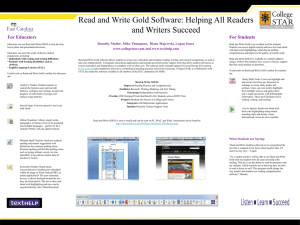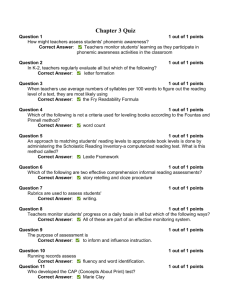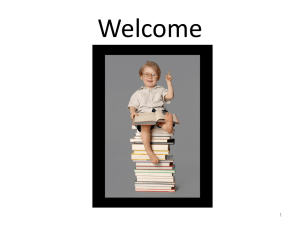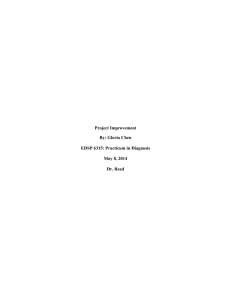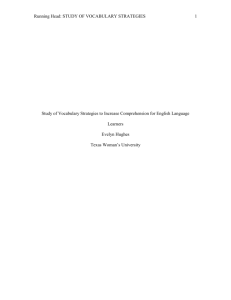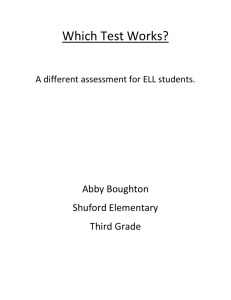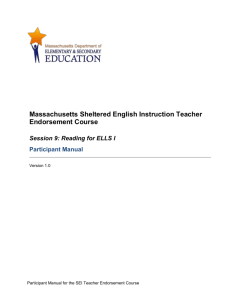Strategy Implementation Report
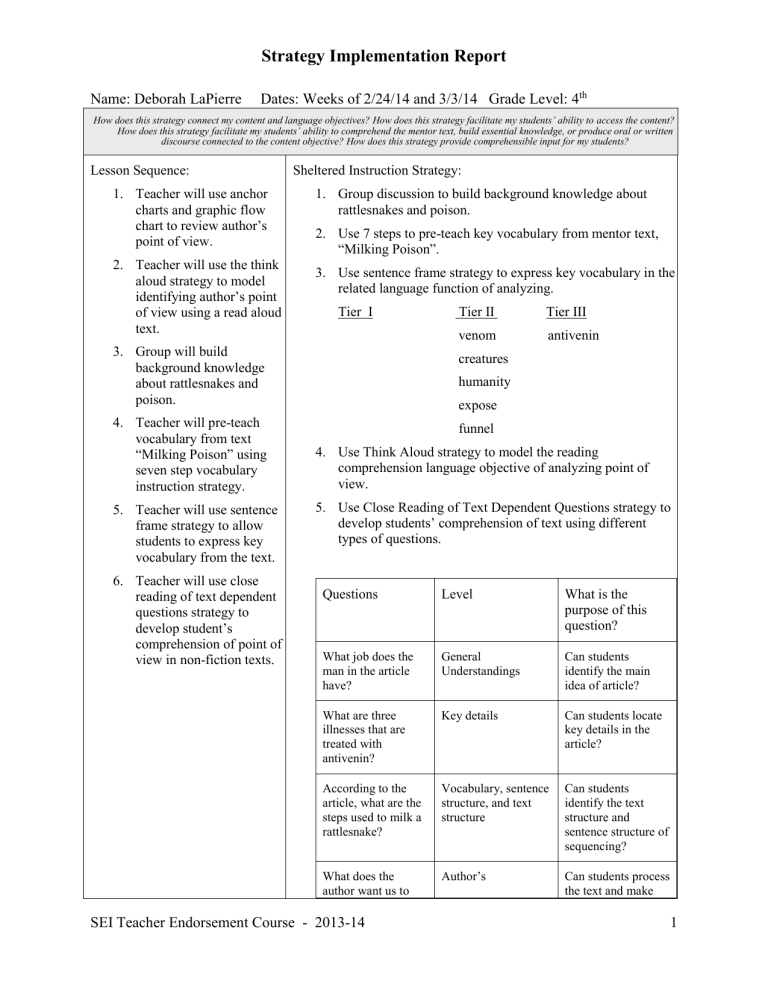
Strategy Implementation Report
Name: Deborah LaPierre Dates: Weeks of 2/24/14 and 3/3/14 Grade Level: 4
th
How does this strategy connect my content and language objectives? How does this strategy facilitate my students’ ability to access the content?
How does this strategy facilitate my students’ ability to comprehend the mentor text, build essential knowledge, or produce oral or written discourse connected to the content objective? How does this strategy provide comprehensible input for my students?
Lesson Sequence: Sheltered Instruction Strategy:
1.
Teacher will use anchor charts and graphic flow chart to review author’s point of view.
1.
Group discussion to build background knowledge about rattlesnakes and poison.
2.
Use 7 steps to pre-teach key vocabulary from mentor text,
“Milking Poison”.
2.
Teacher will use the think aloud strategy to model identifying author’s point of view using a read aloud text.
3.
Use sentence frame strategy to express key vocabulary in the related language function of analyzing.
Tier I Tier II Tier III
venom antivenin
3.
Group will build background knowledge about rattlesnakes and poison. creatures
humanity
expose
4.
Teacher will pre-teach vocabulary from text
“Milking Poison” using seven step vocabulary instruction strategy.
funnel
4.
Use Think Aloud strategy to model the reading comprehension language objective of analyzing point of view.
5.
Teacher will use sentence frame strategy to allow students to express key vocabulary from the text.
5.
Use Close Reading of Text Dependent Questions strategy to develop students’ comprehension of text using different types of questions.
6.
Teacher will use close reading of text dependent questions strategy to develop student’s comprehension of point of view in non-fiction texts.
Questions
What job does the man in the article have?
Level
General
Understandings
What is the purpose of this question?
Can students identify the main idea of article?
What are three illnesses that are treated with antivenin?
Key details Can students locate key details in the article?
According to the article, what are the steps used to milk a rattlesnake?
What does the author want us to
Vocabulary, sentence structure, and text structure
Can students identify the text structure and sentence structure of sequencing?
Author’s Can students process the text and make
SEI Teacher Endorsement Course - 2013-14 1
Strategy Implementation Report know about his job? purpose/inferring conclusions about the importance of the job, danger of the job, and author’s enjoyment of the job?
How would this article be more interesting if it was written in 3 rd person? Why or why not?
Opinions, arguments Can students defend a position using details and evidence from the text?
Content Objective:
Students will analyze how authors use point of view to convey meaning in a variety of texts.
Language Objective:
Language Objectives should be directly linked to the language skills students will need to be successful in achieving the content objective.
Students will analyze point of view in a non-fiction text.
Language Objective Differentiation for Proficiency Levels:
The students are level 4 students and one level 3 student. I will give the level 3 student a bookmark with key words for 1 st person narrative: I, me, my, mine, us, 2 nd person narrative you, your and
3 rd person narrative: He, she, they, them, their, (a name)
I will also offer this bookmark to my level 4 students because many of them have communication, language, or reading comprehension disabilities.
The last question of the text dependent questions uses the language objectives of defending, inferring, and debating. These are all level 5 ELL objectives. My level 4 and level 3 students will need additional support to answer this question. I plan to discuss the question as a group orally first and to develop a list of key points and/or sentence starters on the board. Students will then have visual models to help them respond in writing.
SEI Teacher Endorsement Course - 2013-14 2
Strategy Implementation Report
Content and Concept Language Integration:
How have I integrated all possible domains into my teaching and learning strategies and activities?
How did this strategy help to make the content comprehensible to ELLs in my classroom?
By first building background knowledge about the topic and then using the think aloud strategy to model identifying point of view the students are off to a good start. Next the seven step strategy to pre teach the vocabulary in conjunction with the sentence frame strategy sets the students up to better comprehend a non-fiction text embedded with content specific language. The close reading with text dependent questions gives both me and the students an opportunity to monitor their comprehension skills at increasing levels of complexity. The questions begin with looking for general understanding, move to identifying key details in the text, to being able to identify text and sentence structure that signals sequencing, and then to higher order skills of inferring author’s purpose and offering an opinion and/or argument. So, once again, by combining instructional strategies designed to support
ELLs in content and concept language integration, utilizing all four key domains of language: listening, reading, speaking, and writing my students had the best possible chance for success in meeting the content objective.
How did this strategy help the ELLs in my classroom to produce academic language and discourse?
All of these strategies helped the ELL students in my group access the content vocabulary, and better comprehend this non-fiction article on their way to successfully meeting the content objective for the unit. As a special education teacher, I have the luxury of being able to select high interest texts like this one more often than many classroom teachers. According to Duke and Pearson, 2002,
“Informational text contributes to vocabulary growth and builds knowledge; it capitalizes on students’ interests and curiosities, and provides valuable links to their own experiences”. I work with many boys and many of them are interested in snakes. This made them more enthusiastic about the reading and more willing to share background knowledge and ideas.
Because my students are both ELL and special education students the difficulty of completing academic tasks is even greater. By utilizing the strategies that I have learned to teach vocabulary and reading comprehension in these lessons, my students are developing schema about of point of view and how it impacts writing across genres.
To increase my ELLs’ engagement and interaction, the next time I try this strategy, I would …
The next time I try this strategy, I would provide my students with sentence starters to answer each of the text dependent questions. For example, the question, “What are the steps to milk a rattlesnake?”, was challenging to answer for some, even though they could locate the answer in the text. I had to tell them to start with, “The steps to milking a rattlesnake are first, next, next, then, last, etc”. I have been working with my students all year to use TTQA or turn the question around to begin a response, and yet, some continue to struggle. I believe that is because they are not only ELL students but special education students as well. Many of them have disabilities in communication, language, and writing that compound their difficulties with comprehension skills and activities.


